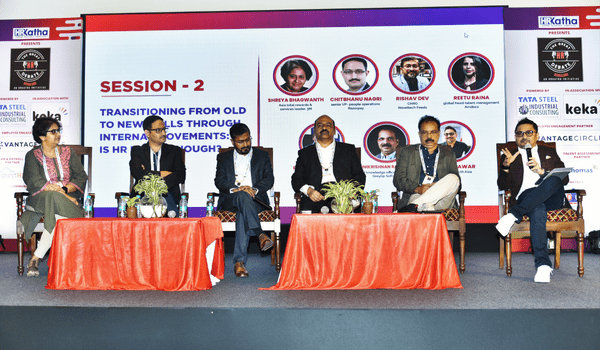As new skills emerge, organisations find it increasingly difficult to come up with new ways to move talent internally and discover new roles that suit the latest corporate needs. Our workforce today is constantly evolving. Roles that were unheard of a decade ago are an essential part of our corporate make-up today. In contrast, roles and skills that may have seemed absolutely necessary in the past may not be as vital in the present.
Figuring out how to evolve with these demands and cope with new skill requirements is now an integral part of a solid HR structure. Unfortunately, in recent times, it seems that the HR function has not done a good job of anticipating the required skill
The layoffs can be attributed to a massive miscalculation in talent requirements in the IT sector. Following the boom the tech industry experienced during the pandemic, many resorted to overhiring. Therefore, these layoffs can be seen as a balancing of the scales.
Identifying the skill requirements of an organisation and ways to develop talent accordingly should be a key focus for HR today. Understanding where the HR function falters and how they can better cope with new talent requirements is what industry stalwarts Shreya Bhagwanth, Asia total rewards and services leader, 3M; Chitbhanu Nagri, sr. VP – peoples operations, Razorpay; Rishav Dev, CHRO, Noveltech feeds; Pradeep Nerayanuri, chief talent management, Tata Steel and Unnakrishnanan Raghavan, chief knowledge officer, Greytip Software debated on in a session moderated by Unmesh Pawar, CPO, Densu at The Great HR Debate, 2023.
Are new skills a reality?
With the pace at which most functions in the corporate landscape are developing, organisations are trying to understand whether there is an actual need for more skilled talent or whether these new requirements are a product of the rapidly increasing needs of the IT industry.
“In a multinational environment, the skills of the present in India could very well be the skills of the future in a country we are investing in.”
Chitbhanu Nagri, sr. VP – people operations, Razorpay
For Bhagwanth, the context regarding the need for new skills may be different than it was in the past but the need for organisational agility has remained the same.
Nagri expands on the same point, highlighting the present situation and how organisations approach new skill requirements.
“For organisations today, the very skill that required a small team a few years ago is an organisational requirement today, due to changes in the regulatory environment since the pandemic,” says Nagri.
Understanding how organisations look at skill development in large MNCs is also important. The foresight required, in terms of future investments and partnerships, can very well change the skills needed by a company.
“In a multinational environment, the skills of the present in India could very well be the skills of the future in a country we are investing in. Understanding how to transport skills to new environments to better our investments is a key focus in that context,” said Nagri.
The need and context may differ from what it was before, but the requirement for more skilled talent was always prevalent. Organisations have to be more anticipatory in terms of skill development and talent needs.
“Organisations need to have a foot in the present (today) and a foot in the future (tomorrow),” opined Pawar when talking about the same.
“Organisations need to have a foot in the present (today) and a foot in the future (tomorrow).”
Unmesh Pawar, CPO, Densu
Where have organisations faltered?
The skill market today is rather volatile. Organisations are moving talent from anywhere between two to five years, because of new skill requirements, creating an unsustainable practice of hiring and firing in the short term.
Pawar believes this new trend should pave the way for a better internal skill development and talent-rotation programme within organisations. Why haven’t we seen that happen yet?
“Most of the discussions around talent and skill development are usually a reaction to when organisations need to understand why attrition rates may be high, or why they aren’t able to hire the right talent, making it too late,” said Nagri.
Expanding on the same, Dev details how an organisation’s talent and skill needs have to be closely related to the state of its industry.
“Having appropriate data to understand the landscape of the market is vital when trying to understand the skill and talent needs of an organisation. Having inaccurate data on the industry can be a key reason behind the organisation not being able to anticipate its needs,” explained Dev.
“We urge our employees to update their skills in our database at frequent intervals to give our managers a fair view of the skills in the workforce.”
Shreya Bhagwanth, Asia total rewards and services leader, 3M
In the absence of a well-rounded understanding of the skills of their employees, organisations have to often resort to hiring from outside. Creating a database of sorts that will help organisations understand the skills of their employees can solve this issue, but the implementation needs to be foolproof.
Bhagwanth talked about how her organisation has been able to create a quasi database to understand the skills existing in its workforce.
“We urge our employees to update their skills in our database at frequent intervals, allowing for our managers to have a fair idea of what skills their team may possess and being able to judge how to move forward using that knowledge,” shared Bhagwanth.
“Having appropriate data to understand the landscape of the market is vital when trying to understand the skill and talent needs of an organisation.”
Rishav Dev, CHRO, Noveltech Feeds
Understanding what skills are
Defining what skills they require in relation to their workforce is vital for organisations that aspire to create an internal talent ecosystem.
Pradeep Nerayanuri divides skills into leadership skills, transferable skills and domain and function-related skills.
“Skills that help promote a more inclusive and safe work environment in the workplace, understanding how to solve key issues in an organisation and tackling new-age problems such as ‘work from home’ are instances of the skills that can be categorised under ‘leadership’,” enunciated Nerayanuri.
Additionally, “skills relevant and fungible throughout various functions such as project management, digitalisation and innovation can be examples of transferable skills.”
“Skills that help promote a more inclusive and safe work environment in the workplace, understanding how to solve key issues in an organisation are leadership skills.”
Pradeep Nerayanuri, CTM, Tata Steel
Lastly, “domain- and function-related skills are the basic skill requirements for a particular role. For instance, in finance, there is a group of skills necessary for one to complete one’s tasks in that function,” said Nerayanuri.
These definitions make it easier for organisations to understand where their skill gaps are and how they can fill them through internal rotation.
How do we move forward?
A common solution suggested by the panellists of the debate, to understand the skills of the workforce was the creation of an internal, intuitive talent marketplace. Most of the organisations featured on the panel have worked towards creating a marketplace that consolidates the information and is easily accessible.
For small organisations, Raghavan believes that an effective way to ensure utilisation of an employee’s skills and foster a culture of learning is by conducting personal interviews.
“At my organisation, we conduct personal reviews, going through the skills of the employees and understanding how they will grow in relation to them.”
Unnakrishnan Raghavan, CKO, Greytip Software
“At my organisation, we conduct personal reviews, going through the skills of the employees and understanding how they will grow in relation to them. We also understand that much can be learnt from new opportunities, and therefore, encourage the employee to inculcate new skills to better their progression,” shared Raghavan
Organisations have to create an environment where employees feel comfortable sharing their skills and knowledge and have a platform to present them in a concise manner.
Communicating the needs of the employers to the employees, so as to give them the opportunity to take on that skill is a must. This can help promote a work environment that believes in internal movement.
The event is powered by Tata Steel Industrial Consulting in association with Keka HR. Other partners are Vantage Circle (employee engagement partner), Greyt HR (HR and payroll partner), Thomas Assessment ( talent assessment partner ) & NHRD Bangalore Chapter (community partner). The event is supported by XLRI Alumni Bangalore Chapter & XISS Alumni Bangalore Chapter.










1 Comment
It was indeed a great insightful session. Looking forward to more such debates